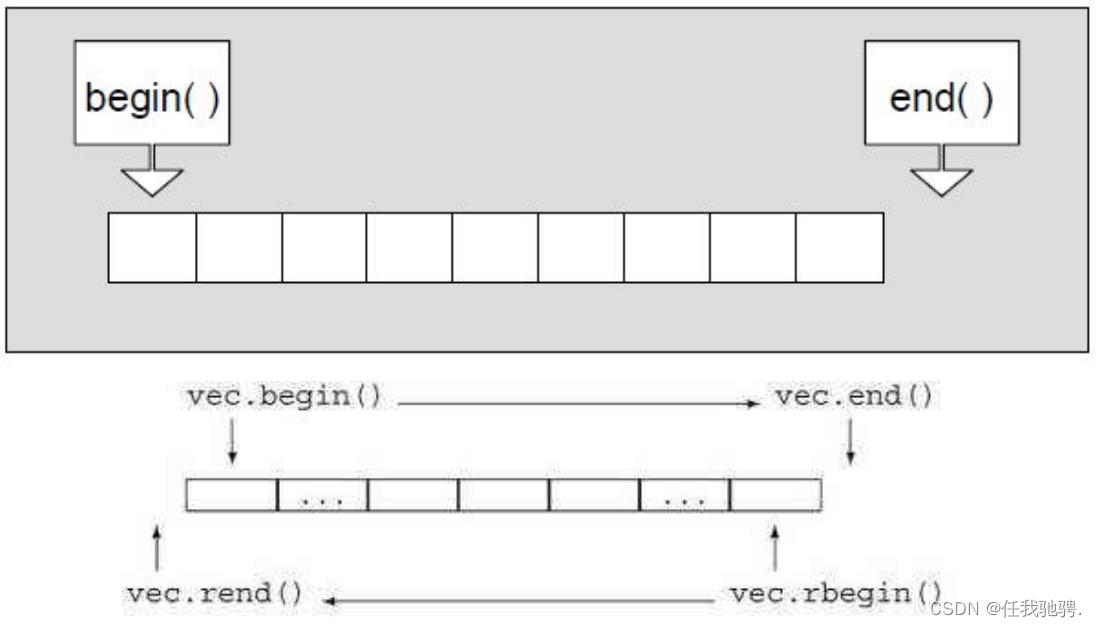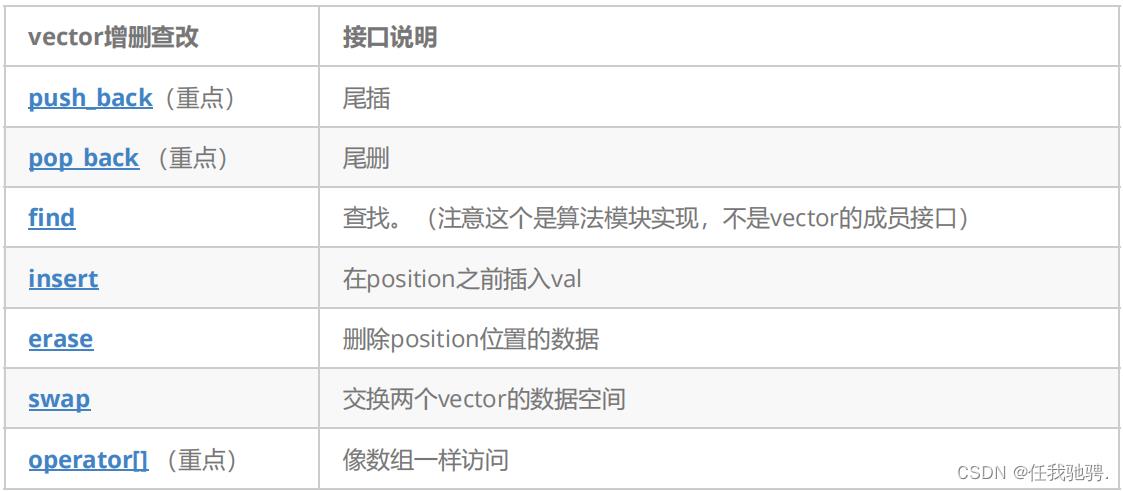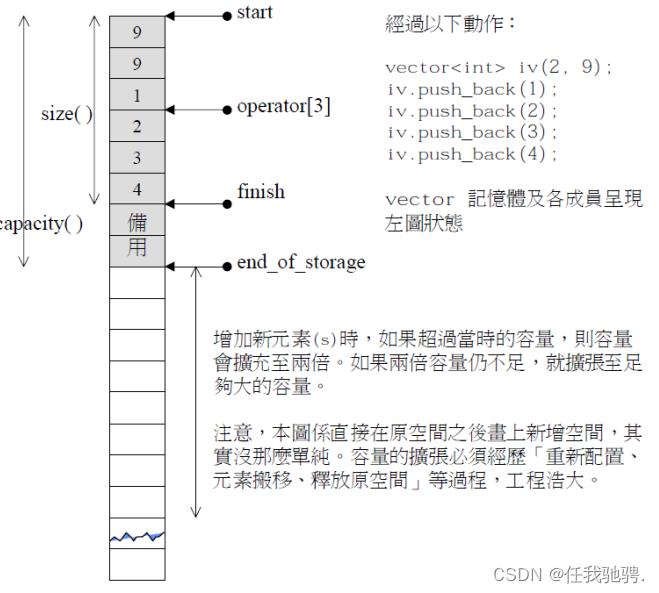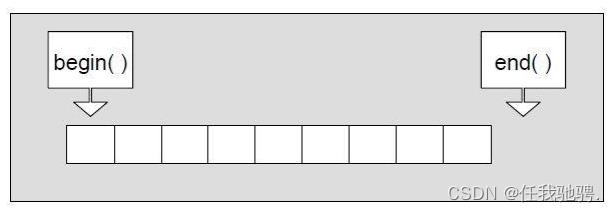C++ vector
Posted 任我驰骋.
tags:
篇首语:本文由小常识网(cha138.com)小编为大家整理,主要介绍了C++ vector相关的知识,希望对你有一定的参考价值。
vector
一、vector的介绍及使用
- vector是表示可变大小数组的序列容器。
- 就像数组一样,vector也采用的连续存储空间来存储元素。也就是意味着可以采用下标对vector的元素进行访问,和数组一样高效。但是又不像数组,它的大小是可以动态改变的,而且它的大小会被容器自动处理。
- 本质讲,vector使用动态分配数组来存储它的元素。当新元素插入时候,这个数组需要被重新分配大小为了增加存储空间。其做法是,分配一个新的数组,然后将全部元素移到这个数组。就时间而言,这是一个相对代价高的任务,因为每当一个新的元素加入到容器的时候,vector并不会每次都重新分配大小。
- vector分配空间策略:vector会分配一些额外的空间以适应可能的增长,因为存储空间比实际需要的存储空间更大。不同的库采用不同的策略权衡空间的使用和重新分配。但是无论如何,重新分配都应该是对数增长的间隔大小,以至于在末尾插入一个元素的时候是在常数时间的复杂度完成的。
- 因此,vector占用了更多的存储空间,为了获得管理存储空间的能力,并且以一种有效的方式动态增长。
- 与其它动态序列容器相比(deques, lists and forward_lists), vector在访问元素的时候更加高效,在末尾添加和删除元素相对高效。对于其它不在末尾的删除和插入操作,效率更低。比起lists和forward_lists统一的迭代器和引用更好。
vector的使用:
vector的定义

// constructing vectors
#include <iostream>
#include <vector>
int main ()
// constructors used in the same order as described above:
std::vector<int> first; // empty vector of ints
std::vector<int> second (4,100); // four ints with value 100
std::vector<int> third (second.begin(),second.end()); // iterating through second
std::vector<int> fourth (third); // a copy of third
// 下面涉及迭代器初始化的部分,我们学习完迭代器再来看这部分
// the iterator constructor can also be used to construct from arrays:
int myints[] = 16,2,77,29;
std::vector<int> fifth (myints, myints + sizeof(myints) / sizeof(int) );
std::cout << "The contents of fifth are:";
for (std::vector<int>::iterator it = fifth.begin(); it != fifth.end(); ++it)
std::cout << ' ' << *it;
std::cout << '\\n';
return 0;
vector iterator 的使用


#include <iostream>
#include <vector>
using namespace std;
void PrintVector(const vector<int>& v)
// const对象使用const迭代器进行遍历打印
vector<int>::const_iterator it = v.begin();
while (it != v.end())
cout << *it << " ";
++it;
cout << endl;
int main()
// 使用push_back插入4个数据
vector<int> v;
v.push_back(1);
v.push_back(2);
v.push_back(3);
v.push_back(4);
// 使用迭代器进行遍历打印
vector<int>::iterator it = v.begin();
while (it != v.end())
cout << *it << " ";
++it;
cout << endl;
// 使用迭代器进行修改
it = v.begin();
while (it != v.end())
*it *= 2;
++it;
// 使用反向迭代器进行遍历再打印
vector<int>::reverse_iterator rit = v.rbegin();
while (rit != v.rend())
cout << *rit << " ";
++rit;
cout << endl;
PrintVector(v);
return 0;
vector 空间增长问题

capacity的代码在vs和g++下分别运行会发现,vs下capacity是按1.5倍增长的,g++是按2倍增长的。这个问题经常会考察,不要固化的认为,顺序表增容都是2倍,具体增长多少是根据具体的需求定义的。vs是PJ版本STL,g++是SGI版本STL。
reserve只负责开辟空间,如果确定知道需要用多少空间,reserve可以缓解vector增容的代价缺陷问题。
resize在开空间的同时还会进行初始化,影响size。
// vector::capacity
#include <iostream>
#include <vector>
int main ()
size_t sz;
std::vector<int> foo;
sz = foo.capacity();
std::cout << "making foo grow:\\n";
for (int i=0; i<100; ++i)
foo.push_back(i);
if (sz!=foo.capacity())
sz = foo.capacity();
std::cout << "capacity changed: " << sz << '\\n';
vs:运行结果:
making foo grow:
capacity changed: 1
capacity changed: 2
capacity changed: 3
capacity changed: 4
capacity changed: 6
capacity changed: 9
capacity changed: 13
capacity changed: 19
capacity changed: 28
capacity changed: 42
capacity changed: 63
capacity changed: 94
capacity changed: 141
g++运行结果:
making foo grow:
capacity changed: 1
capacity changed: 2
capacity changed: 4
capacity changed: 8
capacity changed: 16
capacity changed: 32
capacity changed: 64
capacity changed: 128
vector 增删查改

// find / insert / erase
#include <iostream>
#include <algorithm>
#include <vector>
using namespace std;
int main()
int a[] = 1, 2, 3, 4 ;
vector<int> v(a, a + sizeof(a) / sizeof(int));
// 使用find查找3所在位置的iterator
vector<int>::iterator pos = find(v.begin(), v.end(), 3);
// 在pos位置之前插入30
v.insert(pos, 30);
vector<int>::iterator it = v.begin();
while (it != v.end())
cout << *it << " ";
++it;
cout << endl;
pos = find(v.begin(), v.end(), 3);
// 删除pos位置的数据
v.erase(pos);
it = v.begin();
while (it != v.end())
cout << *it << " ";
++it;
cout << endl;
return 0;
vector迭代器失效问题
迭代器的主要作用就是让算法能够不用关心底层数据结构,其底层实际就是一个指针,或者是对指针进行了封装,比如:vector的迭代器就是原生指针T。因此迭代器失效,实际就是迭代器底层对应指针所指向的空间被销毁了,而是用一块已经被释放的空间*,造成的后果是程序崩溃(即如果继续使用已经失效的迭代器,程序可能会崩溃)。
对于vector可能会导致其迭代器失效的操作有:
- 会引起其底层空间改变的操作,都有可能是迭代器失效,比如:resize、reserve、insert、assign、push_back等。
#include <iostream>
using namespace std;
#include <vector>
int main()
vector<int> v1,2,3,4,5,6;
auto it = v.begin();
// 将有效元素个数增加到100个,多出的位置使用8填充,操作期间底层会扩容
// v.resize(100, 8);
// reserve的作用就是改变扩容大小但不改变有效元素个数,操作期间可能会引起底层容量改变
// v.reserve(100);
// 插入元素期间,可能会引起扩容,而导致原空间被释放
// v.insert(v.begin(), 0);
// v.push_back(8);
// 给vector重新赋值,可能会引起底层容量改变
v.assign(100, 8);
/*
出错原因:以上操作,都有可能会导致vector扩容,也就是说vector底层原理旧空间被释放掉,
而在打印时,it还使用的是释放之间的旧空间,在对it迭代器操作时,实际操作的是一块已经被释放的
空间,而引起代码运行时崩溃。
解决方式:在以上操作完成之后,如果想要继续通过迭代器操作vector中的元素,只需给it重新
赋值即可。
*/
while(it != v.end())
cout<< *it << " " ;
++it;
cout<<endl;
return 0;
- 指定位置元素的删除操作–erase
#include <iostream>
using namespace std;
#include <vector>
int main()
int a[] = 1, 2, 3, 4 ;
vector<int> v(a, a + sizeof(a) / sizeof(int));
// 使用find查找3所在位置的iterator
vector<int>::iterator pos = find(v.begin(), v.end(), 3);
// 删除pos位置的数据,导致pos迭代器失效。
v.erase(pos);
cout << *pos << endl; // 此处会导致非法访问
return 0;
erase删除pos位置元素后,pos位置之后的元素会往前搬移,没有导致底层空间的改变,理论上讲迭代器不应该会失效,但是:如果pos刚好是最后一个元素,删完之后pos刚好是end的位置,而end位置是没有元素了,那么pos就失效了。因此删除vector中任意位置上元素时,vs就认为该位置迭代器失效了。
#include<iostream>
#include<vector>
using namespace std;
方法1:
int main()
vector<int> v 1, 2, 3, 4 ;
auto it = v.begin();
while (it != v.end())
if (*it % 2 == 0)
v.erase(it);
++it;
return 0;
方法2:
int main()
vector<int> v 1, 2, 3, 4 ;
auto it = v.begin();
while (it != v.end())
if (*it % 2 == 0)
it = v.erase(it);
else
++it;
for (auto num : v)
cout << num << " ";
return 0;
实验证明方法2可行。
迭代器失效解决办法:在使用前,对迭代器重新赋值即可。
vector相关OJ
二、vector深度剖析


动态二维数组理解
// 以杨辉三角的前n行为例:假设n为5
void test5(size_t n)
// 使用vector定义二维数组vv,vv中的每个元素都是vector<int>
bit::vector<bit::vector<int>> vv(n);
// 将二维数组每一行中的vecotr<int>中的元素全部设置为1
for (size_t i = 0; i < n; ++i)
vv[i].resize(i + 1, 1);
// 给杨慧三角出第一列和对角线的所有元素赋值
for (int i = 2; i < n; ++i)
for (int j = 1; j < i; ++j)
vv[i][j] = vv[i - 1][j] + vv[i - 1][j - 1];
bit::vector<bit::vector> vv(n); 构造一个vv动态二维数组,vv中总共有n个元素,每个元素都是vector类型的,每行没有包含任何元素,如果n为5时如下所示:

vv中元素填充完成之后,如下图所示:

使用标准库中vector构建动态二维数组时与上图实际是一致的。
以上是关于C++ vector的主要内容,如果未能解决你的问题,请参考以下文章